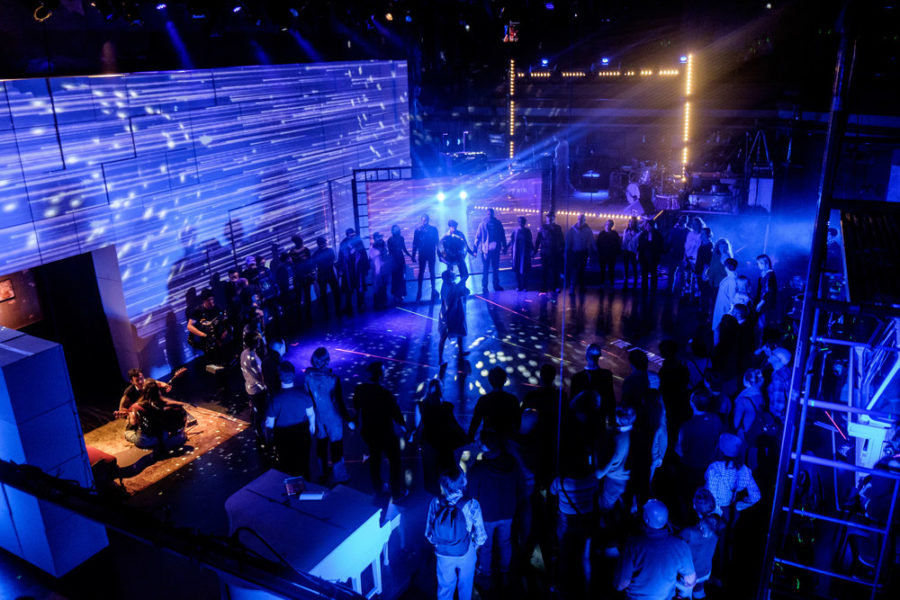In receiving the Presenter of the Year Award from NAPAMA during the Association of Performing Arts Professionals’ (APAP) annual luncheon, Todd E. Wetzel began his acceptance speech with a simple statement: “We don’t do this work in order to win awards. We do it to create community, while simultaneously belonging to one.”
His words uplifted the multiplicity of ways community exists in the performing arts. There are the artists who assemble as collaborators over a period of time to create something of beauty for their own and the public’s growth and enjoyment. There is the community that an audience temporarily becomes while engaging with that work of art. There is the community within an arts organization, united by a mission to produce and present memorable arts experiences. There are the neighborhoods and civic entities that are changed by having the artistry nearby and accessible. And there are the local, national, and global communities that performing arts professionals form over time. These layers of community don’t exist in every sector of society, and it is intensely rewarding to be a part of any one of them, and hence a part of them all.
New York City hosts a concentrated iteration of the global art-making community each January, when a plethora of festivals and conferences joins the city’s burgeoning arts schedule. APAP draws thousands from around the nation and globe to attend showcases, performances, and learning sessions, while networking with friends and colleagues reinforces the extended family we can build in this profession. This critical mass of artists, presenters, and other enthusiasts gives way to adjacent festivals: Under the Radar, Winter Jazzfest, American Realness, Prototype, and GlobalFest (a one-night stand of music from around the world). The International Society for the Performing Arts’ (ISPA) convening in New York comes next, and some organizations, including TCG, will follow all of this U.S.-based activity with delegations to Santiago a Mil International Festival in Chile.
I had some beautiful experiences with these layers of community during festival season. At Under the Radar, Astrov’s Lounge: Music From the Chekhov Project brought together nine years of musicians and composers from the Chekhov Project, an annual weeklong gathering at the upstate home of directors Brian Mertes and Melissa Kievman in which professional theatremakers and musicians “explore and explode” a Chekhov play. As they made their way through the set list, the massive group onstage gradually exited in ones and twos, leaving just a small group there to perform some of the gorgeous tunes of Lila Blue, who began composing for the Chekhov Project at the age of 9 (she’s now 18).
At Prototype’s opening performance of The Infinite Hotel, co-produced with Irondale of Brooklyn, the live filmed performance involved a good deal of standing up and taking direction, as well as some seated moments with headphones amplifying the sotto voce of film-set dialogue. The audience became a community by having a job to do together. Essentially, we were the extras! At one point a late-arriving attendee sat next to me, tapped me on the shoulder, and introduced himself and his wife. I in turn introduced them to my sister, who was visiting from Baltimore. After a marathon of Angels in America or Shakespeare’s history plays, you may get to know the people sitting next to you. Why not during a two-hour interactive show as well?
Outside of traditional theatre settings, there is also the uniquely inclusive way community can be formed through performance in public spaces. During a meeting of organizations that do such work, its relative absence in the U.S. became clear, as well as its potential to change lives and positively affect our citizenry. Some of the trailblazers in bringing performance to public spaces are individuals such as Jay Wahl at Philadelphia’s Kimmel Center, who presented Olivier Grossetête, the French artist, in mounting The People’s Tower, which yielded an 88-foot imitation of Independence Hall built of cardboard boxes. It relied on community members, those who planned to be there and many who just happened to be passing by, to both erect and destroy it.
Rochester, N.Y.’s fringe festival, helmed by Erica Fee, is the only such festival that regularly programs large-scale work in public spaces. In 2017, they hosted the U.S. premiere tour of the French theatre company Plasticiens Volants and their show Big Bang. And every other year California’s La Jolla Playhouse produces Without Walls, which stages performances in public spaces throughout the San Diego area.
When the NEA released its 2017 survey on public participation in the arts, it revealed that non-musical plays were attended by 9 percent of the population, while reading plays was at 3 percent. Meanwhile outdoor performing arts festivals grew from 20.8 to 24 percent of the population since the NEA started measuring in 2008. The economics of producing theatre in non-traditional, outdoor, and public spaces—which can be both expensive and admission-free—are challenging. But this form also offers new and accessible ways of connecting with community members, and national collaborations can make them more achievable both logistically and financially.
If you are in this performing arts world, you are rewarded every day as one who thinks about and creates community on multiple levels. You also belong to a rich, diverse, and passionate community of artmakers and presenters across the globe who want to make things happen. And this sense of community, of doing what we do together, is a big part of why so many of us do what we do.


